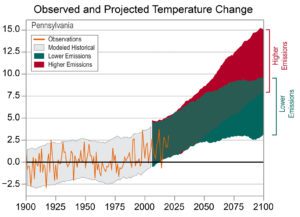Easton Climate Action
Climate Ch ange in Pennsylvania
ange in Pennsylvania
In Pennsylvania, since the start of the 20th century, surface temperatures have increased by 2℉ (mostly in winter and spring) and the number of warm nights and extreme precipitation events have both increased. These warming trends are expected to continue with heat waves becoming more intense and springtime flooding risk increasing.These changes pose a serious threat not just to the City of Easton’s natural resources, but also to our jobs and our health. Climate action also presents huge opportunities for creating a healthier, safer, and more equitable zero-carbon world. The City of Easton has an unparalleled opportunity to make changes in ways that create jobs and benefit all residents.
Climate Change in Pennsylvania
Frankson, R., K.E. Kunkel, S.M. Champion, B.C. Stewart, A.T. DeGaetano, W. Sweet, and J. Spaccio, 2022:
Pennsylvania State Climate Summary 2022. NOAA Technical Report NESDIS 150-PA. NOAA/NESDIS, Silver Spring, MD, 5 pp.
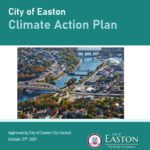 About Easton’s Climate Action
About Easton’s Climate Action
The City of Easton joined the Global Covenant of Mayors for Climate and Energy in 2016, and completed a greenhouse gas inventory in 2016, 2017, 2018, and 2022. A climate vulnerability assessment and an emissions reduction target were developed in spring of 2018. In fall 2020, Nurture Nature Center, on behalf of the City of Easton, participated in the PA DEP Local Climate Action Program, which supported the development of Easton’s Climate Action Plan (CAP) that was adopted by City Council on October 27, 2021. An adaptation plan and a revised CAP and emissions reduction goal (net zero by 2050) were added and adopted in March 2024. The City of Easton is now working to implement strategies in the CAP in order to reach the emissions reduction target goals, including the convening of an Advisory CAP Task Force. Read the CAP here.
How to Get Involved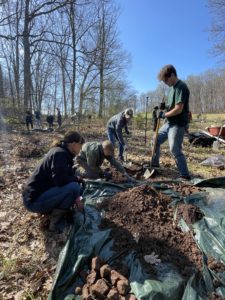
Are you interested in helping Easton reach its sustainability and climate action goals? Everyone can make a difference.
Start by looking at the CAP outline in the website - what strategies are you most interested in and might be able to contribute to? What behaviors or actions do you do at home that you could adjust to reduce emissions? Let us know if you have ideas, comments, or suggestions - reach out to ksemmens@nurturenature.org with your thoughts.
Municipal Operations
 City of Easton is directly responsible for a subset of total community emissions resulting from government buildings, City of Easton fleet vehicles, and management of city-owned land. The actions listed in this section not only reduce the portion of community emissions attributable to city operations, but also present opportunities for the City of Easton to model best practices for cutting emissions and maximizing co-benefits. More here.
City of Easton is directly responsible for a subset of total community emissions resulting from government buildings, City of Easton fleet vehicles, and management of city-owned land. The actions listed in this section not only reduce the portion of community emissions attributable to city operations, but also present opportunities for the City of Easton to model best practices for cutting emissions and maximizing co-benefits. More here.
Commercial Buildings
 Energy consumed in commercial buildings account for 26% of the City of Easton’s total GHG emissions. Improving the efficiency of our commercial building stock and reducing the energy demand will contribute significantly to achieving City of Easton’s greenhouse gas reduction target. More here.
Energy consumed in commercial buildings account for 26% of the City of Easton’s total GHG emissions. Improving the efficiency of our commercial building stock and reducing the energy demand will contribute significantly to achieving City of Easton’s greenhouse gas reduction target. More here.
Residential Buildings
 Energy consumed in residential buildings accounts for 45% of the City of Easton’s total GHG emissions. Improving the efficiency of our residential building stock will contribute significantly to achieving City of Easton’s greenhouse gas reduction target, while saving residents money on utility bills and reducing the need for new infrastructure. More here.
Energy consumed in residential buildings accounts for 45% of the City of Easton’s total GHG emissions. Improving the efficiency of our residential building stock will contribute significantly to achieving City of Easton’s greenhouse gas reduction target, while saving residents money on utility bills and reducing the need for new infrastructure. More here.
Energy Production
 Broadly speaking, the use of fossil fuels for energy (including electricity, heating, transportation, and other uses) is the single largest contributor to greenhouse gas emissions and climate change. Fossil fuels still supply a considerable share of energy for electricity, heating, transportation, and other energy-producing uses. Energy Production is a cross-cutting sector in that nearly all activities that take place in the community require energy of some sort. More here.
Broadly speaking, the use of fossil fuels for energy (including electricity, heating, transportation, and other uses) is the single largest contributor to greenhouse gas emissions and climate change. Fossil fuels still supply a considerable share of energy for electricity, heating, transportation, and other energy-producing uses. Energy Production is a cross-cutting sector in that nearly all activities that take place in the community require energy of some sort. More here.
Waste, Composting, and Recycling
 The City of Easton’s solid waste is disposed of, primarily, at Chrin Brothers Landfill located on Industrial Drive in Williams Township, Northampton County. Emissions from decaying material directly contribute 3% of the City of Easton’s total GHG emissions and contribute to emissions in the Transportation sector via hauling of waste to and from facilities. More here.
The City of Easton’s solid waste is disposed of, primarily, at Chrin Brothers Landfill located on Industrial Drive in Williams Township, Northampton County. Emissions from decaying material directly contribute 3% of the City of Easton’s total GHG emissions and contribute to emissions in the Transportation sector via hauling of waste to and from facilities. More here.
Water & Wastewater Management
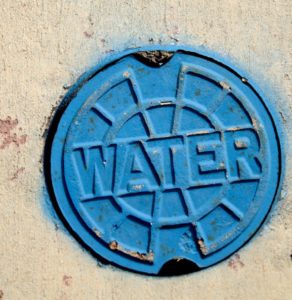 The City of Easton’s water is provided by the Easton Suburban Water Authority, and its wastewater is treated by the Easton Area Joint Sewer Authority. These entities serve Easton and the surrounding municipalities. More here.
The City of Easton’s water is provided by the Easton Suburban Water Authority, and its wastewater is treated by the Easton Area Joint Sewer Authority. These entities serve Easton and the surrounding municipalities. More here.
Transportation
 Transportation is one of the most visible sources of emissions in the City of Easton. Besides emitting greenhouse gases, cars, buses, and trucks that burn fossil fuels also produce a host of criteria air pollutants in exhaust, reducing local air quality and affecting our health. More here.
Transportation is one of the most visible sources of emissions in the City of Easton. Besides emitting greenhouse gases, cars, buses, and trucks that burn fossil fuels also produce a host of criteria air pollutants in exhaust, reducing local air quality and affecting our health. More here.
Urban Forest, Green Space, and Habitat
 One feature that makes Easton an appealing place to live is the presence of trees and parks throughout the city in addition to natural resources like the river front and beautiful trails in the surrounding area. More here.
One feature that makes Easton an appealing place to live is the presence of trees and parks throughout the city in addition to natural resources like the river front and beautiful trails in the surrounding area. More here.
Local Food & Agriculture
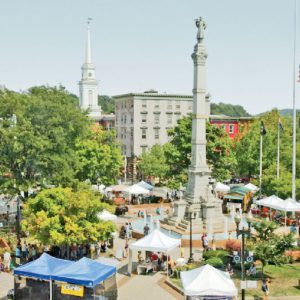 Easton is proud to be home to the Easton Farmers’ Market, the oldest continuous open-air market in the country. In addition, many residents’ long-standing tradition of growing their own food has given rise to a resurgence in community gardening in recent years. More here.
Easton is proud to be home to the Easton Farmers’ Market, the oldest continuous open-air market in the country. In addition, many residents’ long-standing tradition of growing their own food has given rise to a resurgence in community gardening in recent years. More here.
Public Engagement & Education
 Many strategies rely on creating public education programs and on the involvement and support of Easton’s residents to implement. A particularly rich opportunity for climate education exists in Easton’s schools, as young people are increasingly concerned about how action taken on climate change now will affect the course of their lives. More here.
Many strategies rely on creating public education programs and on the involvement and support of Easton’s residents to implement. A particularly rich opportunity for climate education exists in Easton’s schools, as young people are increasingly concerned about how action taken on climate change now will affect the course of their lives. More here.
Adaptation
 Some greenhouse gas reduction measures also reduce risk to climate hazards. More here.
Some greenhouse gas reduction measures also reduce risk to climate hazards. More here.




